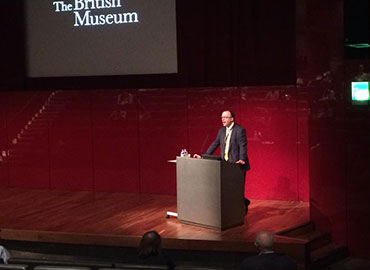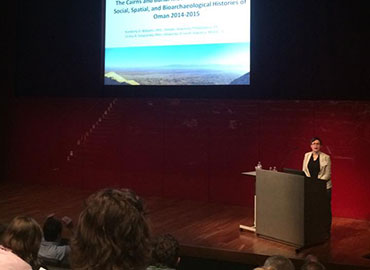|
24/07/2015
MBI Al Jaber Foundation Sponsors 49th Seminar for Arabian Studies
The 49th Seminar for Arabian Studies (SAS) organised by the British Foundation for the Study of Arabia (BFSA) and supported by both the MBI Al Jaber Foundation and the British Museum, took place on Friday 24th July to Sunday 26th July, 2015. Approximately forty papers were presented at the three-day event, with over 150 delegates, the only annual international forum for the presentation of the most up-to-date academic research on the Arabian Peninsula. The papers covered a variety of subjects including archaeology, history, epigraphy and languages as well as literature, art, culture, ethnography and geography with research covering a broad time-scale, from the earliest periods to the present day.
 |
 |
| Dr Jonathan Williams Dep. Director of The British Museum speaking at the 49th Seminar for Arabian Studies 2015 |
Kimberley Williams speaking on "Cairns and burial mounds of Dhank Oman" at the 49th Seminar for Arabian Studies 2015 |
The Seminar on Friday the 24th of July began with papers on the North and South Arabia, chaired by BFSA Trustee Michael Macdonald. Topics of lectures focused mostly on Philological and Linguistic analyses of a variety of different media, such as correspondence on wooden sticks and the ancient calendars of Mecca. There were also papers on Samsi, Queen of the Arabs, the cemetery temple of Marib and an update on the south Arabian collections in the Kunsthistorisches Museum in Vienna. The special afternoon session was chaired by Lucy Wadeson and papers considered the Nabataean Hinterlands of Petra, beyond the “rose-red city.” Presentations included investigations of caravan and road trade routes, the influence of Petra on its satellite towns and other peripheral sites. The Chair also gave a paper on a Nabataean family tomb in the Hinterland of Petra, expanding on the paper that Dr. Wadeson gave prior to the BFSA AGM on the 4th June 2015.
Neolithic Archaeology
The leading session of Saturday 25th July detailed the wealth of work going on throughout the Arabian Peninsula on sites dating to the Neolithic Period, mostly related to coastal sites. Various aspects were covered including seaside cemeteries, Abu Dhabi coastal heritage initiatives and subsistence and environmental change in Oman. During the coffee break some of the poster designers were on hand to speak to delegates about their research. The Poster entries for this year were many and varied. They included Irrigation Systems in Qattara Oasis, Predynastic Egyptian Cultural Influences in North-west Arabia, Dilmun and Kassite Pottery, Iron Age Metallurgy, comparisons of Umm an Nar Domestic Architecture, monumental tower tombs in Mleiha… to name but a few!
Bronze and Iron Ages in Eastern Arabia
The mid-morning session was chaired by Christian Velde and discussed various aspects of archaeological excavations and research undertaken throughout Arabia. Papers included cairns and burial mounds of Dhank, Oman by Williams and Gregoricka, and 2 papers on pottery of the sites of al-Ain, Al-Zebah and Bat. However, the highlight for the session was a visit by H.R. H. Shaikha Obaid Al Abbar and guests who arrived especially to attend the paper given by Prof Lloyd Weeks et al on the New Collaborative Research at Saruq al-Hadid, Dubai, U.A.E. The site has revealed some mysterious finds. Saruq al-Hadid is located in the middle of the desert, yet contains thousands of copper artefacts and some evidence for gold working too, dating to the Late Bronze Age. There are no domestic architectural remains, nor tombs, so the site is very puzzling for the archaeologists.
Islamic Archaeology
Derek Kennet chaired the afternoon session on Islamic Archaeology, which in the main focused on either pottery or mosques (an unusual mix!), with the exception of Buraimi Project update by Tim Power and team. The Ceramics papers focused on the sites of Freiha (Bystron) and al-Ain Oases (Živović et al.) The paper by Velde et al. on The Friday Mosque of Ras al-Khaimah highlighted the plight of these early mosques in the Arabian region, which were often demolished in favour of modern concrete versions. The coral walled mosque at Ras al-Khaimah by contrast is still surviving due to the local Sheikh’s will to remember his grandfather who built the mosque in the 19th century. During excavations of part of the mosque, Velde discovered a destruction layer, which he knew dated to 18th July 1820, sometime between 3-7pm, as that was when the British left Ras al-Khaimah, afer blowing most of it up! How rare to get such a specific date in archaeology!
MBI Lecture: Prof Peter Magee (Bryn Mawr College)
“'Turning the world upside down: the emergence of camel caravans and overland trade in the Ancient Near East'”
In the evening of Saturday, Professor Peter Magee, Professor of Near Eastern Archaeology and Director of Middle Eastern Studies at Bryn Mawr College, delivered the MBI Al Jaber Lecture in the BP lecture theatre. In his very interesting and somewhat controversial lecture, Professor Magee explored how the use of dromedaries for overland trade fundamentally reconfigured the political and economic landscape of the ancient Near East. He discussed why the dromedary was domesticated and how it was used, suggesting food as a motivating factor – female camels for the provision of milk and young males for their meat. Peter Magee also explained that evidence at Tell Abraq suggests it was not until c1000BC that dromedary camels were used for transport. During this period, settlement intensification throughout Arabia led to increased productivity and trade in goods, and the need for those goods to be transported. He believes that with the increased activity, camel caravans became a destabilising factor in that they were able to bypass control of the state and taxation, and giving rise to a situation which may perhaps have contributed to the fall of Babylon itself.
Archaeological Survey and Field Methods
After a short one-paper session on the swords of Zanzibar by Stéphane Pradines, the rest of the morning session focused on archaeological survey and field methods. Participants shared the latest news and research on the scientific landscape surveys being undertaken across the Arabian region. Peter Spencer discussed the results of terrestrial and maritime remote sensing in Qatar. One of the problems Spencer highlighted in particular was the issues on-site destruction when vehicles are used by locals to drive all over the ancient remains that they are visiting as tourists. Louise Purdue outlined the latest geoarchaelogical research being undertaken in the oases in Masāfi, and suggested that the origins of irrigation in the region might soon be realised.
Heritage Management in Arabia
The final special session discussed the methods being employed to make archaeological sites more accessible to tourists, with papers including Endangered Archaeology in the Middle East and North Africa by Robert Bewley, and the plans for developing Ras al-Khaimah into a managed, accessible tourist-friendly site.
The 49th Seminar for Arabian Studies was a huge success, and it is hoped that the 50th will be even better. For more information on the Seminar, see www.thebfsa.org/content/about-the-seminar
For further information, please contact:
Director of Public Relations
[email protected] |




